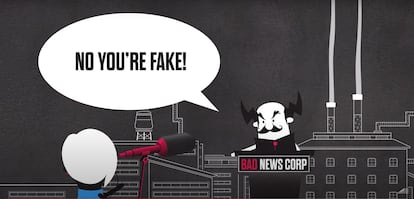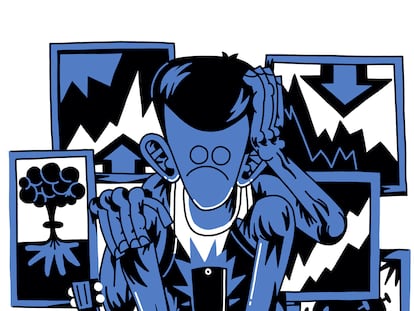Why does fake news fascinate us?
Various studies have identified the brain mechanisms that make us buy into online hoaxes, while offering up ‘vaccines’ to prevent against misinformation

Hoaxes are a phenomenon as old as humanity. But, in the internet age, with the dominance of social media, they can spread on a massive scale.
Andrea Grignolio Corsini teaches History of Medicine and Bioethics at Vita-Salute San Raffaele University in Milan. He addressed the subject of hoaxes at the largest European conference on neuroscience, the FENS Forum: “Fake news tends to create exclusion dynamics between different social groups… it consists of information manipulated with something real or of manufactured origin, created for political purposes.”
Grignolio says that this has been going on for a long time. He recounts how the Donation of Constantine – a forged Roman imperial decree, by which Constantine the Great supposedly transferred authority over Rome and the western part of the Roman Empire to the Pope – was revealed as a falsehood in 1440. The Italian philosopher Lorenzo Valla showed that the text used terms, expressions and grammar that did not exist in the Latin used at the time of the alleged drafting of the decree.
Since then, there have been manipulated texts against racial minorities, discoveries of life on the Moon (published by The Sun in 1845) and dozens of other examples of fake news well before the emergence of the internet. The new, digital version of this phenomenon has played an important role in key events, such as the 2016 American presidential election, the Brexit referendum and the Covid-19 pandemic.
A research paper published last month in the journal Science explores the fierce fighting that took place between false and scientific information regarding Covid-19 vaccines at the height of the pandemic. Following a study of 1,365 Facebook pages, the researchers from George Washington University concluded that “the battle to get the best scientific guidance from Facebook users was lost to misinformation early in the pandemic, because some [parties] acted as dominant sources of guidance, while others were mostly recipients of it. When the acceptance of vaccines became essential, many parents – who were responsible for the health decisions of their young children and elderly relatives – had already reached out to anti-vaccine communities on social media,” explains Lucia Illari, co-author of the paper.
Another recent study carried out by the Communications Department at Carlos III University of Madrid has analyzed whether students between the ages of 11 and 16 are capable of distinguishing fake news from real information:
“Some 58.8% of the students [believed] a false headline about Covid, while 51.8% considered a headline containing a falsehood about immigration to be true,” says Eva Herrero, one of the study’s authors. The research also indicates that most of the teenagers surveyed inform themselves through social media (55.5%), television (29.1%) and their family and friends groups (7.9%)... well ahead of online newspapers (6.5%) or radio (1%).
This last poll is very relevant. According to Grignolio, the vast new dimension of fake news is due to “a new social media ecosystem,” where falsehoods are generated by groups of like-minded users. In his opinion, virtually-circulated disinformation is based on “novelty or surprise,” the generation of “moral disgust,” polarization – which allows group feeling to be reinforced – and the appeal to emotions.
These elements subsequently reach the brain, where areas related to dopamine – which regulates emotion – and glutamate – the main excitatory neurotransmitter – are activated, explains Maria Antonieta de Luca, a professor of Biomedical Sciences at the University of Cagliary, Italy. Activating the area of the brain related to satisfaction has important consequences.
Ciara Greene, Director of the Attention & Memory Lab at University College Dublin, details how one of the main effects of disinformation is the formation of false memories: “When people see fabricated news stories – or even doctored photos of events that never took place – they may not only come to believe that those events did indeed happen... they may also form a detailed memory of actually experiencing those events. This effect is more likely if the content of the fabricated material is consistent with your biases.”
“Memories,” she explains, “are stored and distributed throughout the brain. Every time we remember something, we actually reconstruct that memory. [Memories] are like Lego blocks.”
Research from the University of Texas has shown that sharing news articles with friends and followers on social media can prompt people to think you know more about a topic than you really do. Thus, false memory is exacerbated by the erroneous perception of knowledge.
“When people feel that they are more informed, they are more likely to make riskier decisions,” warns Adrian Ward, who participated in the research. Susan M. Broniarczyk – lead author of the paper on new articles – adds: “If people feel more informed about a topic, they also feel that they may not need to read or learn additional information about it.”
Is there a solution to all of this? A group of researchers from the universities of Cambridge and Bristol, in collaboration with Jigsaw – a unit within Google – think there is, especially after conducting an experiment titled “Inoculation Science.” The project consists of the creation of 90-second-long clips that familiarize viewers with manipulation techniques, so that they can better identify falsehoods regardless of the topic at hand.
Sander van der Linden, one of the researchers from Cambridge, says: “[This project] provides the necessary proof that psychological inoculation can easily be scaled to hundreds of millions of users worldwide.” Almost like a vaccine!
The videos improved the ability of people, from all walks of life, to spot misinformation. They also improved decision-making about whether or not to share harmful content.
“The inoculation effect was consistent between liberals and conservatives. It worked for people with different levels of education and different personality types. This is the basis for a general inoculation campaign against disinformation,” adds Jon Roozenbeek, lead author of the research from Cambridge.
Google has announced that Jigsaw will launch an immunization campaign on various social media platforms in Poland, Slovakia and the Czech Republic, to preemptively halt emerging misinformation related to Ukrainian refugees. The campaign is designed to counter harmful anti-refugee narratives, in partnership with local NGOs, fact-checkers, academics and disinformation experts.
The team argues that the inoculation method may be more effective than verifying each falsehood after it spreads. “Propaganda and lies are almost always created from the same pattern… fact-checkers can only refute a fraction of the falsehoods circulating online. We need to teach people to recognize patterns of misinformation, so they understand when they are being misled,” says Stephan Lewandowsky of the University of Bristol.
The researchers believe that the benefits of “vaccines” against disinformation would be greater if they were incorporated across all social media platforms. The estimated cost for each view is a mere 0.05 cents.
Tu suscripción se está usando en otro dispositivo
¿Quieres añadir otro usuario a tu suscripción?
Si continúas leyendo en este dispositivo, no se podrá leer en el otro.
FlechaTu suscripción se está usando en otro dispositivo y solo puedes acceder a EL PAÍS desde un dispositivo a la vez.
Si quieres compartir tu cuenta, cambia tu suscripción a la modalidad Premium, así podrás añadir otro usuario. Cada uno accederá con su propia cuenta de email, lo que os permitirá personalizar vuestra experiencia en EL PAÍS.
¿Tienes una suscripción de empresa? Accede aquí para contratar más cuentas.
En el caso de no saber quién está usando tu cuenta, te recomendamos cambiar tu contraseña aquí.
Si decides continuar compartiendo tu cuenta, este mensaje se mostrará en tu dispositivo y en el de la otra persona que está usando tu cuenta de forma indefinida, afectando a tu experiencia de lectura. Puedes consultar aquí los términos y condiciones de la suscripción digital.
More information
Últimas noticias
Most viewed
- Reinhard Genzel, Nobel laureate in physics: ‘One-minute videos will never give you the truth’
- Oona Chaplin: ‘I told James Cameron that I was living in a treehouse and starting a permaculture project with a friend’
- Pablo Escobar’s hippos: A serious environmental problem, 40 years on
- Why we lost the habit of sleeping in two segments and how that changed our sense of time
- Chevy Chase, the beloved comedian who was a monster off camera: ‘Not everyone hated him, just the people who’ve worked with him’











































